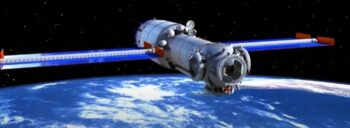China has successfully flown a modified version of the Long March-7 rocket, a booster that represents a new generation of the country’s medium-sized high-orbit rocketry. The launcher adds to the tool kit of available rocket power to sustain and enhance China’s budding agenda of putting in place their own space station, as well as shoulder robotic and human sojourns to the Moon and beyond.
The Long March-7A Y2 carrier rocket lifted off early Friday morning (Beijing time) from the Wenchang Spacecraft Launch Site in south China’s island province of Hainan. The maiden flight of the CZ-7A back in March 2020 ended in failure.
Atop the modified booster was the Shiyan-9 satellite, primarily used for in-orbit tests of new technologies including space environment monitoring, according to Chinese news accounts.
Meet the demand
China’s Xinhua news agency reports that, along with Long March-3A and Long March-5 carrier rockets, the Long March-7A will undertake the country’s high-orbit missions.
The Long March-3A rocket can carry payloads of 5.5 tons to GTO, and the Long March-5 can send payloads of 14 tons to GTO.
Meng Gang, chief director of the rocket project, said the Long March-7A is expected to carry out three to five missions annually before 2025 reports Xinhua. Upgrades of the launch vehicle are scheduled to meet the demand for sending satellites and deep-space probes to explore the Moon, Mars and asteroids.
Space station module
In the meantime, China is pressing forward on its space station construction plans.
In a few months, China will launch the Tianhe core module, the foundational element of their orbital facility slated to be completed in 2022. It will start the construction of the nation’s largest space-based asset, according to the China Manned Space Agency.

China’s Tianwen1 now in Mars orbit, ready to unload a lander/rover in May-June.
Credit: CCTV/Inside Outer Space screengrab
China appears to be on the verge of a one-two punch in both the country’s human space flight program as well as its robotic planetary exploration plans.
Before the end of June, the China National Space Administration (CNSA) notes it anticipates the lofting of the 20-metric-ton core module. China is also targeting an attempted landing on Mars in May-June with the Tianwen-1’s lander/rover – the country’s first independent mission to the Red Planet.
Multi-type rockets
To piece together China’s space station in rapid fashion, the nation will sequentially launch the Tianhe core capsule, Wentian and Mengtian lab modules.
In addition, four Shenzhou crew-carrying spacecrafts and four Tianzhou cargo spacecrafts will also be lofted to establish a rotation of astronauts to work on the space station and supply goods to sustain station operations.
“This is the first time that we will launch multi-type Long March rockets to build a manned space station. The carrier rocket Long March-5B will launch the core module of the space station. Then the Long March-7 carrier rocket will launch the cargo spacecraft. Later, the Long March-2F carrier rocket will carry our astronauts to our space station,” said Mou Yu, director of the General Design Department of the China Academy of Launch Vehicle Technology explained in a recent China Central Television (CCTV) interview.

China’s space station agenda also includes lofting an optical module that carries a space telescope, touted as having a better field angle than the NASA Hubble space telescope.
Credit: China Manned Space (CMS)/CCTV/Inside Outer Space screengrab
Hubble rival
Upon commissioning the space station, China will also loft an optical module that carries a space telescope, touted as having a better field angle than the NASA Hubble space telescope. Zhou Jianping, chief designer of China’s manned space program, said that the telescope with resolution ratio equivalent to the Hubble telescope will have a 2-meter diameter lens with a field of view 300 times that of the Hubble telescope.
“The telescope will be set up in an optical module that can fly independently in orbit for a higher efficiency of space probe. Meanwhile, we will make it fly approximately in common orbit with the future space station,” Zhou told CCTV. “This will help us refuel the telescope and carry out in-orbit upgrade for it, so as to always keep it on the level of an international frontier.”
The orbiting telescope can survey large areas in space in the coming 10 years, Zhou added. “We will explore the mysteries of the stars and very deep space, including the origin and evolution of the cosmos, as well as the important scientific frontier issues including dark holes, dark matter and dark energy.”
Boots on the Moon
As chief designer of China’s manned space program Zhou said that the country plans to send astronauts to the Moon for scientific exploration. The space station will lay the ground for China’s further manned space exploration, such as future crewed lunar missions, he said.
“We are in the process of deepening the assessment of manned lunar exploration and tackling key technical problems. We have the determination and the hardworking spirit to achieve manned lunar exploration for Chinese people,” Zhou told CCTV. “Moreover, we have set our goal higher than merely setting foot on the Moon, meaning that we will be using modern technology and conducting scientific exploration when our astronauts reach the Moon.”
Go to this CCTV video describing the Long March-7A at:







